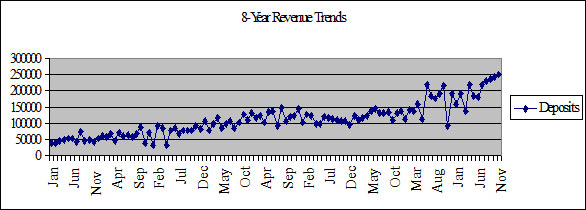Look at the big picture when worried about a light appointment book, part 1
In mid-winter and mid-summer, my office phone starts ringing in earnest. “John, you’ve got to get in here. Our volume is going through the floor.”
These normal seasonal lulls in patient volume are often misinterpreted by clients as the harbinger of disaster. In a few cases, these concerns are warranted. But more often, light clinics and surgical calendars are driven by normal seasonal market forces, some of which are under administrative control. Slips in volume that you can’t control can at least be predicted and braced for in advance.
Diagnosing the difference between seasonal lulls and a truly adverse practice trend is a fundamental practice management challenge, easily addressed with a few simple graphs.

In the graph above, I’ve shown the 8-year revenue (collection) trends for a growing two-surgeon practice. As you can see, in several recent months, revenue went through wild gyrations, up and down. Were it not for this long-term graph, these doctors might be alarmed about the trend of their practice. But as this graph shows, the practice’s long-term trends are indeed very favorable.
As it turns out, with further investigation we found that the up-and-down collection swings were due to three overlapping factors: a new computer system, new billing staff and unusually lengthy doctor vacations. Once these factors were stabilized, revenue trends were back on track, as the graph indicates.
You can obviously also measure the long-term trends in other performance data, such as practice costs or case volume. It can be particularly useful to measure the long-term graphic trends of common performance ratios, such as the revenue per FTE-month (the monthly collections divided by the full-time equivalent staff count in your practice) or the practice’s surgical density (the total monthly patient visits divided by the number of major surgical cases).
